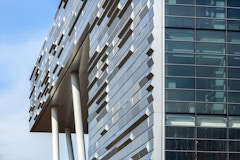
Façade Systems and Embodied Carbon
Life Cycle Assessment (LCA) is a methodology used to quantify the impact of building construction supply chains on the environment in terms of

Life Cycle Assessment (LCA) is a methodology used to quantify the impact of building construction supply chains on the environment in terms of


In the vein of mass production, manufacturers leverage repeatable parts and modular construction in an effort to maximize quality control while




As architects and designers we understand the urgency of addressing the building sector’s role in the ongoing environmental crisis. Architecture2030

The traditional building facade as a permanent construction does not actively respond to the differing needs from varying weather conditions.


Kinetic or responsive facades have been developed to improve buildings' daylighting conditions while mitigating energy consumption. Still, these

With the advent of more sophisticated analysis methods and the desire to optimize geometries of structural silicone joints in high performance

Building envelopes cover a considerable part of the urban exterior surfaces, and to therefore have a significant leverage effect on the climate

Architects today must explore alternative enclosure materials to meet evolving energy codes and embodied carbon regulations. Terra cotta has been

The recently completed Capital One Hall performing arts center located in the Washington DC metro area is defined by a pleated exterior of glass and

Today’s environmental challenges highlight the necessity of a holistic approach to façade design and construction, key to achieve the ambitious 2030

Double-Skin Facades (DSF) are well-known to boost the thermal performance of a façade: they can provide extra insulation in the wintertime and lower


Thermal discomfort can occur in perimeter zones due to radiant heat loss from the occupant to a poorly insulated exterior wall. It is valuable for

Nowadays, the power of images is seductive. Bold and complex facades often have an innovative appearance but superficial tectonic depth;
